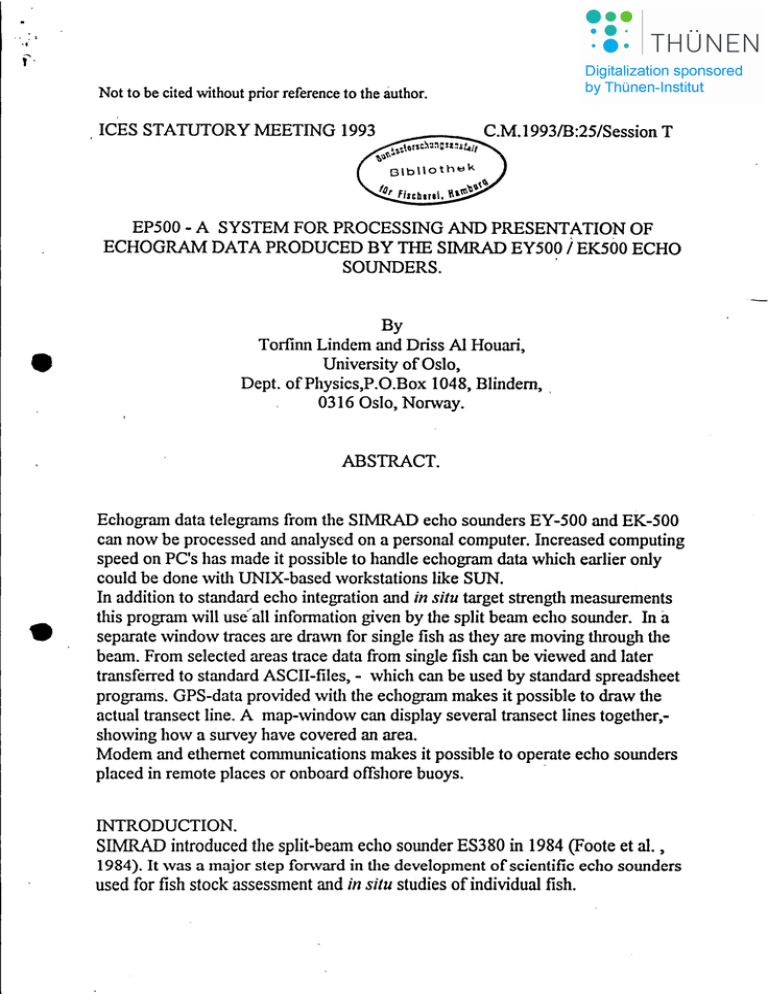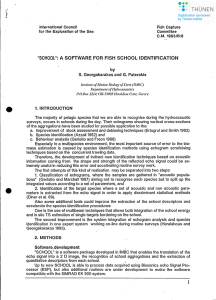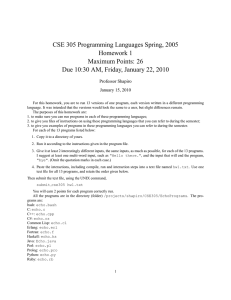C.M.19931B:25/Session
advertisement

..
.,:
~
Not to be cited without prior reference to the author.
ICES STATUTORY MEETING 1993
_ _- . C.M.19931B:25/Session T
EP500 - A SYSTEM FOR PROCESSING AND PRESENTATION OF
"
ECHOGRAM DATA PRODUCED BY THE SIMRAD EY500 I EK500 ECHO
SOUNDERS.
'
'
By
Torfinn Lindern and Driss Al Rouari,
University of Oslo,
Dept. ofPhysics,P.O.Box 1048, Blindem,
0316 Oslo, Norway.
ABSTRACT.
•
Echograrn data telegrarns from the SIMRAD echo sounders EY-500 and EK-500
can now be processed and analysed on a personal computer. Increased computing
speed on PC's has made it possible to handle echograrn data which earlier only
could be done with UNIX-based workstations like SUN.
In addition to standard echo integration and in situ target strength measurements
this prograrn will use/all infonnation given by the split bearn echo sounder. In a
separate window traces are drawn for single fish as they are moving through the
bearn. From selected areas trace data from single fish can be viewed and later
transferred to standard ASCII-files, - which can be used by standard spreadsheet
programs. GPS-data provided with the echograrn makes it possible to draw the
actual transect line. A map-\vindow can display several transect lines together,showing how a survey have covered an area.
Modem and ethernet communications makes it possible to operate echo sounders
placed in remote pIaces or onboard otrshore buoys.
'
INTRODUCTION.
SIMRAD introduced the spIit-beam echo sounder ES380 in 1984 (Foote et al. ,
1984). It was a major step forward in the devetopment ofscientific echo sounders
used for fish stock assessment and in situ studies of individual fish.
,
2
Since then the split-beam teclmology have developed through the ES400:t EK500
and now finally into the EY500 echo sounder. This latest soimder is a small
portable version ofthe EK500, - a wortby successor to the EY-M and EY200P.
The data-teclmology used in these new sounders made it necessary to connect
computers with high performance to handle the vast amount of real time data.
The EK500 communicates through a LAN (Local Area Network) interface of the
TCP/IPIETHERNET type to external post processing and data logging systems. It
was basically designed to co-operate in a network with UNIX based
workstations.
This design made it necessary to develop an on-line/real-time program package to
analyse and store the huge amount of fish data available on the network. Some
users ofthe EK500 have developed their own fish analysing programs, but most
Fisheries Research institutes have adapted the program called the Bergen
Integrator, BI.
However, this program running on a SUN workstation ~ave made the whole
EK500/BI-concepfvery costly. It has not made this new technology available to .
many potential users.
Tbe aim ofthis project was to develop a new and smaller version ofthe EY500 to
bring the split beam technology into a low-cost LAP-top computer. The on-line
program is running under the RMX operating system, but the post processing
program EP500 has been developed in C++ under MS-DOS:t Microsoft's
operating system for personal computers. In the process of developing this post
processing program we soon found that new personal computers based on Intel
•
386 and 486 microcomputers had a formidable computing power. It became
apparent tlIat a lot of the facilities found in the BI-program could be implemented
on a 486 based pe. Even on-line ethernet communication was not a problem for
such systems.
As a result the EP500 was developed to work on-line in real time with EK500
echo sounders and/or as a post processing program for both the EK500 and
EY500.
OVERVIEW OF THE EP500 PROGRAM.
A personal computer Witll standard VGA-graphics is the main platform for tlle
EP500 program. The software is specially developed for logging raw data in the
form of "data telegrams" from the EK500 and EY500 sounders. In the case of
EK500 these telegrams are read in real time on the Ethernet, - on the EY500 they
.
can be found in data files located on the hard-disk.
These echo sounders, in addition to be self-contained echo integrators and target
strength measurement devices, deliver integrated vaIues for small depth intervals
in each sounding.
2
3
,,
,
Data stored on hard-disk or received via the communication channels
represent the complete dataset for each ping. Each of the 250 vertical pixels used
to reproduce the echograrn on the screen represent a set of information. With the
echo-data presented in "pixel mode" it is easy to defme layer limits in accordance
with the displayed echograrn. Several modules for data analysis are provided,
including echo integration and target strength measurements both for pelagic,
surface and bottom locked layers. The results from such an analysis are displayed
on the screen together with the echogram. See figure 1. They can be printed or
saved as an ASCII-file which later easily can be loaded into a "spread-sheet"
prograrn like EXCEL or statistical prograrns like SAS or SPSS
Prant
"~I'"
.....
~rSon
Pt
0.\ •• 0 / ' . "
'il#Uil
ASCII_ra._
-.,..
~
to t fiCI
Nl7rwUo.OT'1 'c8
;.-;-:-0.'1..,..,..... . . . .
~":
..
. -:- . .-...... : ""-~.....;;... ': .. '-_. ~ -- - ..
~~~-:-~=--:--o.;;-~~-:.::-~.....,;,,:>-'":l4' .--:.-
•
37'
~
Figure J. Echogram with selected areasfor analysis. Fish data from the upper
frame are displayed belmy the echogram.
ECHOGRAM DATA.
Raw data from the echo sounder are sent to Ethernet or disk as aseries of "data
telegrarns". These telegrarns consists of a header with position data, log counter
and bottom depth, followed by the Sv values.
The vertical resolution can be selected betweeri 1 m and 10 cm and is set in
accordance to the bottorn deptlI. In addition, there are expanded values (for each
10 cm) representing the 15 m bottom layer.
The computer screen allows a display ofa maximwn of600 pings horizoritally.
This means that if a transect contains more than 600 pings, which is often the
case, only a fraction of tlIe echograrn would be displayed. To displaya full
picture of a'large transect, EP500 displays one in every "n" pings, where "n"
depends on the total nwnber of pings in tlie transecl.
3
-- ----------------
.,
4
A "Zoom" option is provided to select and displayany part ofthe echogram in
more details. Tbe log results, originally generated by the sounder and often
printed on the echogram paper, are stored within the data file. Tbey can be
displayed on the screen under the echogram together with the lines defming the
log markers.
TRACE TRACKING.
Tbe SIMRAD split beam echo sounders are able to position single fish in the
beam. (Brede et al., 1987) Tbis makes it possible to track single fish and plot
there movement through the beam. See Figure 2. Three predefined parameters are
decisive for the trace tracking a1gorithm:
• The minimum number of traces to start tracking a fish.
• The allowed depth difference (in cm) between consecutiv~ traces.
• The a1lowed consecutive missing pings in aseries oftraces.
All three parameters can be altercd to match any specific criteria.
••
52
!l8
.'
61
• of c»1.cHorw 1:0 tr..a • Ush
I
~'WNn "e<';ians
N1Cl'Md ..... "9 P'~ pw trKk
"ish trac. .....-ber
I 30
I
1
• •7
nax ca
877
87.
......
aeo
881
"0.1
10.111
10.111
10.111
10.20
10.2tS
_...
-"t;;."
-44.1
-W.3
-w.II
_.2
..
3.2
1.1
-I ••
-3.11
-11.6
-.
-0.6
-1.3
-0.2
0.4
-0..
Figure 2. An example 0/ an individualfish traced through the beam olthe echo
sounder. The. actualfish displayed in the "trace window" can be/ound within the
smal/ square box located in the selected area olthe echogram.
Traces within any selected area are plotted on the echogram showing their target
strength, location on the echogram and trajectory within the transducer beam. Tbe
results are stored in an ASCII-file for further analysis by other programs.
4
-
----
-
--------
-•
"
5
GPS CHART PLOTTING.
Ifthe echo sounder is connected to a GPS (satellite navigation) system, the
EP500 can organise several transect-files into a "survey-file" . The transect files
linked together into this "survey-file" can be displayed in an interactive chart.(See
Figure 3.) On this chart every single transect can be accessed and displayed as an
individual echogram. In this way it is easy to get a picture on how fish are
distributed within an area.
··············I :
~
«.-J.----- i
.
........~~~ ......
!
/{'
······t·;;7/~::~·······I···················
)--'----t.:-
..rf~
i
l
Figure 3. EP500 can link together navigation datafrom several transects and
display them toge/her. This interactive chart map show how the survey area has
been covered with -I transect /ines.
.
)
COMMUNICATION.
Communication represents a central part in the EP500. In addition to the ethernet
communication with the EK500 sounder, it is able to communicate with the
EY500 and EK500 echo sounders through their serial port. The EP500 program
and EY500 can communicate directly via modem. In this way EP500 can log into
remote echo sounders, like on offshore buoys, arid plot the echogram in real time
or transfer stored data files.
SUMMARY.
The EP500 program does not only brings many post processing features into a
personal computer, it is also able to run on-line with the EK500 and EY500 echo
5
.•
6
"
sounders. In the case ofEK500 this is done via ethernet, on the EY500 via
modem.
We have found the program easy to operate and the analysis provided covers
many research areas. One of the most important features with the program is the
ability to provide ASCII-files for almost any available data. These ASCII-files are
in a CSV-format which can be imported into most third party programs. Users
with special interests will find these ASCII-files very useful for further studies.
REFERENCES
Brede, R., Kristensen, F.H., Solli, H., Ona, E. 1987. Target tracking with split
beam echo sounder. International Symposium on Fisheries Acoustics, Seattle,
Washington, 22-26 lune 1987. 22pp.
Foote, K.G., Finn Hogne Kristensen and Haakon Solli. 1984. Trial ofa new,
split-beam echo sounder. ICES CM./B:21 15 pp.
6






